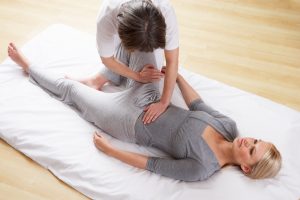 While attending massage therapy school you will learn different types of massage, how each can benefit your future clients, and which modalities (types) work best for each client’s unique situation. There are many types of massage and bodywork and they each serve a unique purpose. If you feel an affinity for a specific modality, you can specialize by taking Continuing Education (CE) courses after graduation. To learn more about the specific modalities you’ll learn at ASIS Massage Education, check out our course descriptions page.
While attending massage therapy school you will learn different types of massage, how each can benefit your future clients, and which modalities (types) work best for each client’s unique situation. There are many types of massage and bodywork and they each serve a unique purpose. If you feel an affinity for a specific modality, you can specialize by taking Continuing Education (CE) courses after graduation. To learn more about the specific modalities you’ll learn at ASIS Massage Education, check out our course descriptions page.
Here is an overview of the most common modalities:
Connective Tissue Massage (CTM)
Connective Tissue Therapy (CTT)
CTM, or CTT, is a deep form of massage that targets fascia (the connective tissue, mostly collagen, that surrounds the bones, muscles, and joints). This modality is used to return muscles to a relaxed state and promote relaxation, vitality, increased awareness of posture, ease of mobility, and increased range of motion.
Craniosacral
Craniosacral Therapy refers to the use of light touch on the head and bottom of the spine in order to reduce pain and tension.
Deep Tissue Therapy
Deep tissue therapy, also called deep tissue massage or deep muscle therapy, refers to the application of strong pressure on the tendons, muscles, and fascia. DTT is commonly used to alleviate chronic pain.
Neuromuscular Therapy (NMT)
NMT focuses on releasing acute or chronically contracted muscles and tendons by applying specific and direct point pressure on specific sites of muscular irritation in order to relieve pain, often felt as “knots” in the muscles.
Oncology Massage
This type of therapy applies modified massage therapy techniques to safely help people undergoing cancer treatment and cancer complications. Massage therapists modify traditional massage techniques with an understanding of the disease, its effects on the body, and the side effects of treatments such as medication, chemotherapy, and surgery.
Polarity Therapy
Polarity therapy consists of light touch and gentle rocking movements intended to balance the body’s chi (life force energy) to induce general and muscular relaxation.
Pregnancy Massage
This modality benefits women during (prenatal) and after (post natal) pregnancy. Pregnancy Massage is used to relieve the common aches and pains that affect pregnant and post natal women, such as those felt in the lower back, feet, and legs.
Reiki
Reiki is a form of bodywork that uses a light touch or no-touch technique to balance the flow of the body’s chi in order to promote natural healing.
Reflexology
During a Reflexology session, pressure is applied on specific points, called acupressure points, in the body that correspond with other areas of the body in order to promote healing.
Shiatsu
There are different styles of Shiatsu, some which focus on the body’s acupressure points, some on general bodywork, and some on energy. Techniques include the use of fingers, thumbs, the palms of the hands, and the feet to manipulate joints, assist with stretching, and increase mobilization.
Sports Massage
Massage therapists blend Swedish Massage techniques with other techniques such as compression, pressure-point therapy, cross-fiber friction, joint mobilization, hydrotherapy, and cryotherapy (ice massage) to help athletes and others with an active lifestyle prepare their bodies for optimal performance, recover after a big event, or stay healthy during training. Sports Massage can also help people suffering from injuries, chronic pain, and restricted range of motion.
Swedish Massage
Swedish massage is one of the most widely recognized massage techniques. It is commonly used to relieve aching muscles and increase relaxation. Swedish Massage consists of muscle and connective tissue manipulation.
Follow us on Facebook and Twitter.
Confirm the types of massage therapy you’re allowed to practice in your area as regulations vary from state to state. This information can usually be found on your state’s occupational licensing or health department websites.